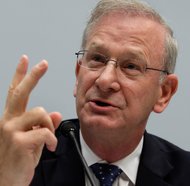So said Chris Lucas, finance director of Barclays, three months ago.
It turns out that a British regulator disagrees.
Shares of Barclays lost 10 percent of their value during the first three trading days of this week after the company disclosed that its capital — as seen by the regulator — needed to grow by 38 percent to be adequate under new rules, unless the bank reduced its assets. And the regulator was not willing to give Barclays as much time as it wanted to raise that capital.
Barclays is scrambling. It plans to sell stock through a rights offering. It plans to raise still more capital through so-called CoCos — contingent convertibles, to the uninitiated. Those are bonds that pay interest unless bank capital levels fall too far. In that case, they automatically convert into stock. It also plans to shed some assets, which reduces the amount of capital that it needs.
Barclays is lucky in one respect. If it were subject to the rules being proposed by regulators for large banks based in the United States, it would need far more capital.
What is going on may come to be known as the revolt of the regulators. They were profoundly embarrassed by the clear evidence that banks were undercapitalized before the credit crisis despite the banks’ claims to the contrary. The revolt is most intense in the financial centers with the biggest banks — the places where the pain to governments would be greatest if another round of bailouts were needed.
It is useful to try to understand why the banks were so undercapitalized that bailouts were needed.
The answer lies in international rules that grew ever more complicated and gave the banks wide latitude to make judgments about the safety of the loans they had made and the securities they had bought.
Bank capital, the financial cushion that banks have to hold to absorb potential losses, is usually expressed as a percentage of “risk-weighted assets.” Some assets receive full weight in the calculations, and some — viewed as virtually risk-free — receive no weight and thus have no effect on how much capital a bank needs.
All that makes sense — if you can figure out the risks. But of course that is not easy. At first, there were fairly simple categories, with a certain type of loan receiving a certain risk allocation. But that led some banks to load up on the riskiest assets within any category and to invent assets that would seem to be low-risk and therefore not need much capital.
As time went on, the rules allowed banks to make more and more judgments. They could use bond ratings from Moody’s or its competitors to determine how safe an asset was. And if they wanted, they could use their own risk models to make the decisions.
How’s that for regulatory abdication? Rather than seek to review and judge bank assets, the regulators essentially allowed the banks to evaluate their own decisions.
After the financial crisis, regulators meeting in Basel, Switzerland, produced a new set of rules, called Basel III. They tightened up what counted as capital and took steps to improve the risk ratings. They raised the required capital levels.
But they did one more thing, and that is turning out to be critical. They adopted leverage ratios for banks.
In principle, a leverage ratio is simple. Calculate how much capital a bank has and divide it by the bank’s total assets, without any risk weighting. In practice, of course, it is not quite so simple. But it is a lot simpler than the other calculation of risk-weighted assets. When all this goes into effect, banks are supposed to meet both sets of rules.
At first, the big banks do not seem to have focused on the leverage ratio. But that is what trapped Barclays and it is what may force several other large banks on both sides of the Atlantic to raise more capital — or dispose of assets to bring down the amount of capital they need.

Article source: http://www.nytimes.com/2013/08/02/business/barclays-caught-short-is-now-in-a-bind.html?partner=rss&emc=rss


